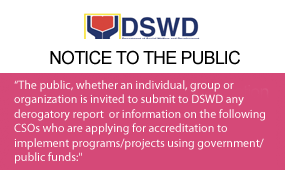 BUTUAN CITY – The Department of Social Welfare and Development recognizes the vital role of statistics in implementing effective and efficient social protection programs and services.
BUTUAN CITY – The Department of Social Welfare and Development recognizes the vital role of statistics in implementing effective and efficient social protection programs and services.
“Statistics. Social protection. Two different fields; each is realm on its own. If these two are put together, the concept of social protection statistics comes to life,” said Director Vincent Andrew Leyson, national project manager of the National Household Targeting System for Poverty Reduction or NHTSPR.
Director Leyson was the guest speaker in the recently concluded National Statistics Month (NSM) celebration and NHTS-PR Database launching in Caraga Region. He said it is indeed timely for the Department to host this year’s NSM as it proudly presents the NHTS-PR Database, the DSWD’s contribution in the improvement of the lives of the poor, disadvantaged and vulnerable Filipinos.
In the presence of Butuan City mayor, Honorable Ferdinand Amante, Jr, regional directors and employees of partner agencies, congressmen/women’s representatives, CSOs, partners from the academe, media and DSWD Caraga personnel, Leyson reiterated DSWD is the lead agency mandated to provide social protection and undertake anti-poverty programs and projects.
It is the reason why the department continues to enhance and strengthen its capacity to meet the challenges.
Some examples of social protection programs in the Philippines cited by Leyson include programs on health, retirement and other benefits from the government, food-for-work programs, subsidies, pension plans, emergency employment, among others.
According to Leyson, the official poverty statistics of 2006 showed that poverty in the country continues to increase, despite implementation of various social protection programs. Using this as one of the baselines, the DSWD tried to identify where the gaps lie.
Having seen the need to have a better system in delivering programs and services, the DSWD developed a targeting system for a more focused delivery of services.
Established in 2009, NHTS-PR is an information management system that identifies who and where the poor are nationwide. It aims to create an objective and transparent database of poor households, which will serve as a guide in identifying beneficiaries of government’s social protection programs.
Leyson explained the process that NHTS-PR underwent to establish its database. He said it utilized the existing poverty statistics such as the 2006 Family Income and Expenditures (FIES) produced by the National Statistics Office (NSO) and the 2003 Small Area Poverty Estimates (SAE) of the National Statistical Coordination Board (NSCB) in the planning and implementation of the project. He also said the data form these surveys guided the NHTS-PR in identifying areas to assess and in determining indicators to measure poverty status of households in the country.
Further, the NHTS-PR used the Proxy Means Test (PMT), a statistical model that uses non-income (proxy) variables in estimating the income of the households. The estimated incomes of the households are then compared to the poverty thresholds as determined by the NSCB to identify who are poor and non-poor. Households with estimated income below the poverty threshold are identified as poor, while those that are above the poverty threshold are identified as non-poor.
Furthermore, Leyson said the DSWD uses the NHTS-PR list of poor households in identifying the Pantawid Pamilyang Pilipino Program beneficiaries and Social Pension for indigent senior citizens. He sais as of September 15, Pantawid Pamilya has covered 143, 151 poor households in Caraga. The poor households are now receiving at the maximum, P1, 400 each for the education and health of their children.
Also, some 9,362 indigent senior citizens ages 77 years old and above in the region are now receiving P 500 monthly stipend to augment their daily and medical needs. # # # (Social Marketing Unit)


